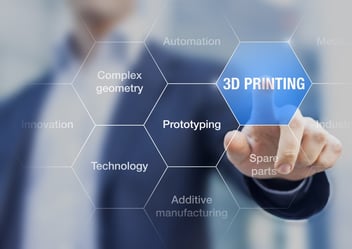CNC machining stands out for its engineering precision, based on complex control software that transforms CAD designs into physical reality. These advanced machines, guided by detailed instructions, perform cutting, drilling, and milling operations with high precision. The ability to directly convert three-dimensional models into operational instructions eliminates human errors and significantly increases production efficiency, allowing for the creation of components with complex geometries that would be difficult, if not impossible, to reproduce manually.
CNC machining is a transformative catalyst touching on crucial aspects such as customization, sustainability, and continuous innovation in the field of industrial production. The ability to integrate these advanced technologies with a strategic vision determines companies' capacity to remain leaders in a globalized and rapidly evolving market.
Sectoral Impact of CNC
The versatility of CNC machining has revolutionized various sectors, making it indispensable in aerospace, where precision is critical, automotive for large-scale component production, and medical for the creation of custom devices. Each sector uniquely benefits from the high precision and efficiency of CNC, pushing the boundaries of productive innovation and enabling the development of products that better meet market and consumer needs, with a direct impact on competitiveness and technological progress.
Mass Customization through CNC
One of the most revolutionary aspects of CNC machining lies in its ability to enable mass customization. The flexibility offered by CNC machines represents an invaluable competitive advantage. This technology allows companies to produce small batches of customized components with the same efficiency and similar costs as traditional mass production. Mass customization has opened new frontiers in product design, enabling unprecedented creative freedom and the ability to cater to previously inaccessible market niches.
CNC and Industry 4.0
CNC machining is a fundamental element of Industry 4.0, which aims to create interconnected and intelligent production systems. Integration with technologies such as artificial intelligence and data analysis allows CNC machines to autonomously optimize production processes, further improving efficiency and reducing downtime by optimizing production processes.
CNC Machining and 3D Printing
CNC machining and 3D printing represent two fundamentally different approaches to industrial production, each with its strengths and limitations. While CNC is a subtractive technology that removes material from a solid block to form a part, 3D printing is additive, building an object layer by layer from a digital model. This fundamental distinction leads to significant differences in terms of applications, efficiency, costs, and environmental impact.
CNC machining is renowned for its precision and reliability, capable of producing parts with tight tolerances and high-quality surface finishes. However, CNC can be more expensive and generate more material waste since the subtractive process removes and discards parts of the starting material. 3D printing excels in rapid prototyping and the production of complex geometries that would be difficult or impossible to achieve with CNC machining. It offers greater flexibility in terms of customization and the ability to efficiently produce small batches or unique pieces.
From an economic standpoint, 3D printing may be more accessible for projects requiring low production volumes without the burden of high initial investments required by CNC machining. However, for large production volumes, CNC machining may be more advantageous in terms of unit costs and lead times.
The choice between CNC machining and 3D printing depends on several factors, including the type of material, the complexity of the design, the production volume, and economic considerations. Both methods play a vital role in modern manufacturing, and the decision on which technology to use should be guided by the specific project requirements and production goals.
The complementarity between CNC and 3D printing suggests that, rather than replacing each other, these technologies can offer integrated solutions that leverage the strengths of both to optimize production.
Integration of CNC Machining and 3D Printing in Production
The contemporary evolution of manufacturing is increasingly oriented towards the synergistic integration of different technologies, prominently including CNC machining and 3D printing. This strategic combination allows for leveraging the precision and excellent surface finish of CNC together with the flexibility and capability to produce complex geometries of 3D printing. Components initially 3D printed can be subsequently refined through CNC machining to improve dimensional tolerance and surface quality, thus combining the best of both worlds.
This integrated approach not only expands design possibilities but also optimizes the production chain, enabling the creation of products that would otherwise be limited by the constraints of each technology. For example, parts with complex internal geometries, which are ideal for 3D printing, can be combined with externally CNC machined components to ensure superior mechanical strength or better interface with other mechanical elements.
Moreover, assembling parts created separately through CNC machining and additive manufacturing offers unprecedented product modularity and customization. This hybrid production mode is particularly advantageous for applications where customization and material optimization are crucial, such as in the aerospace, automotive, and medical sectors.
The integration of CNC and additive manufacturing thus represents an advanced frontier of industrial production, surpassing traditional limits and exploring new creative and functional possibilities. The collaboration between these technologies not only enhances production efficiency and quality but also paves the way for product design innovations, highlighting the potential of an increasingly adaptable and future-oriented manufacturing.
Which material to choose?
AISI 316L
AISI 316L material is a stainless steel alloy characterized by excellent mechanical properties and corrosion resistance, making it ideal for CNC machining. This type of steel is widely used in industrial, aerospace, and medical fields, where precision and reliability are paramount. Thanks to its chemical composition, which includes significant amounts of chromium, nickel, and molybdenum, AISI 316L offers superior corrosion resistance compared to other stainless steels. This feature makes it suitable for the production of components that must operate in aggressive environments or come into contact with corrosive fluids. Additionally, the workability of AISI 316L makes it suitable for CNC machining, allowing the creation of parts with tight tolerances and high-quality surface finishes, crucial in numerous industrial sectors.
Download the technical datasheet
6082
6082 is an aluminum alloy widely used in CNC machining due to its excellent mechanical properties and ease of processing. This alloy exhibits good corrosion resistance and high tensile strength, making it suitable for a wide range of industrial applications. Its workability makes it particularly suitable for creating components with complex geometries through milling, drilling, and CNC cutting. Thanks to its lightweight and strength, material 6082 is often employed in the automotive, aerospace, and mechanical engineering industries for the production of structural parts and precision components. CNC machining of material 6082 enables the achievement of high-quality surface finishes and tight dimensional tolerances, ensuring the precision and reliability required in numerous industrial sectors.
Download the technical datasheet







